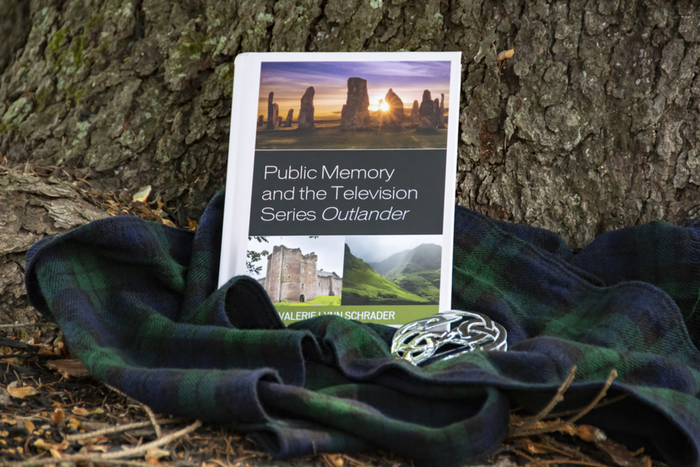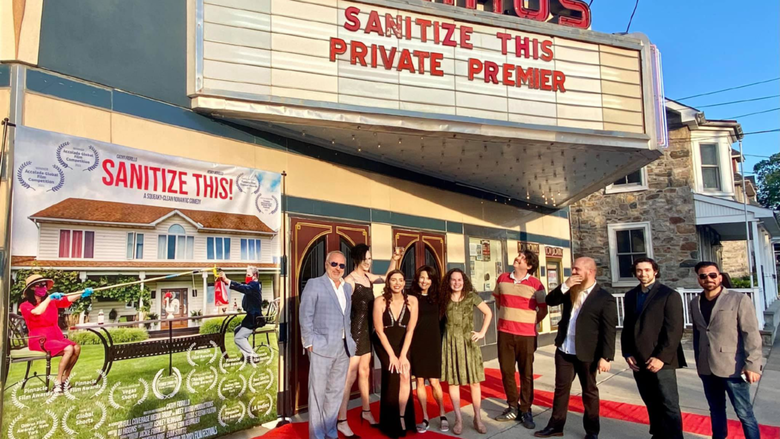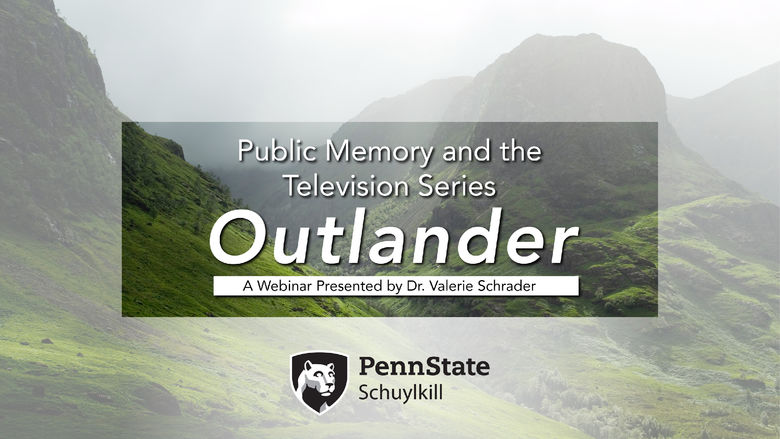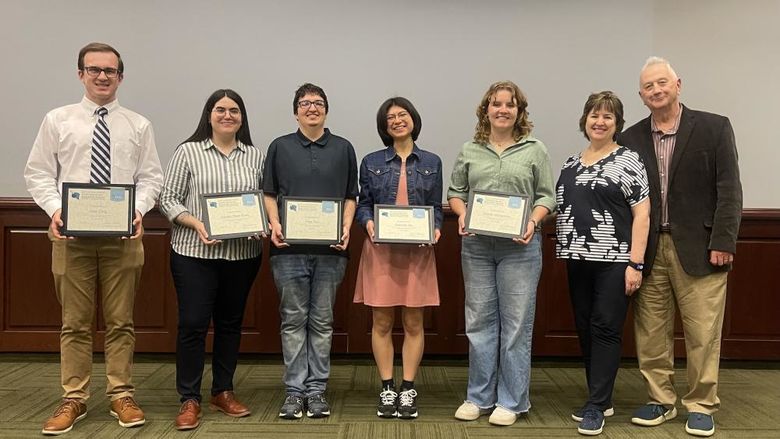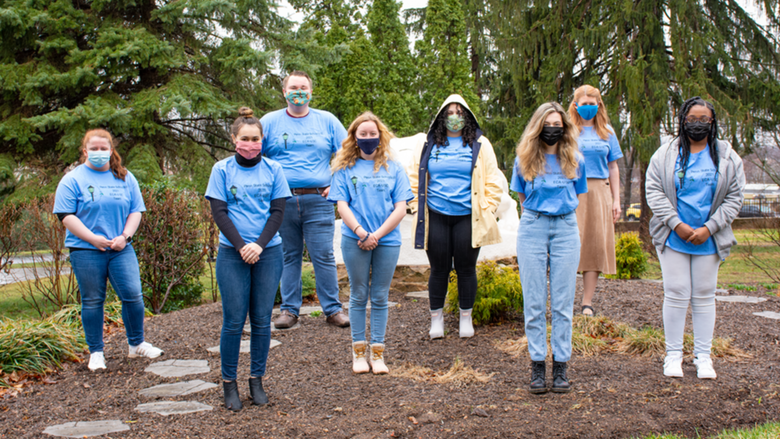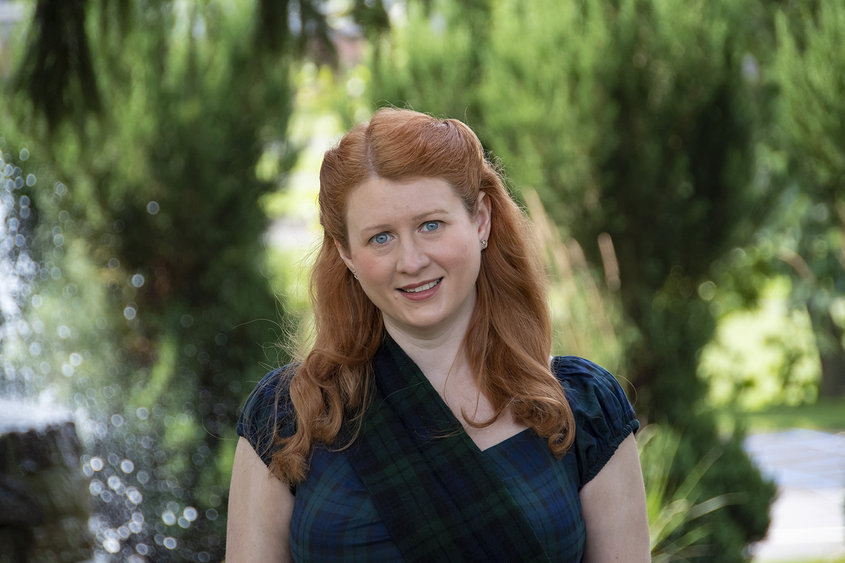
Valerie Schrader, associate professor of communication arts and sciences and coordinator of the Penn State Schuylkill Honors Program
Valerie Schrader, associate professor of communication arts and sciences and coordinator of the Penn State Schuylkill Honors Program, published her first book in January 2021. "Public Memory and the Television Series Outlander," Lexington Books, examines the connections between documented history and the depictions presented in the popular television series. Through rhetorical analysis, Schrader explains how the series shapes public memory — shared beliefs about the past — through its characterization of historical events and how and where public memory both aligns with and diverges from historical accounts.
The manuscript originated as part of a student-led project in the fall of 2017.
From paper to manuscript
Schrader’s book began as a scholarly paper, part of a panel — with three of her communication theory honors students: Brenna Baker, Kyanna Gonzalez and Christina DeMoss — presented at the Eastern Communication Association (ECA) spring 2018 conference in Pittsburgh, Pennsylvania. The students selected public memory in pop culture texts as the topic, and to ensure they would be competitive in the blind review process, Schrader opted to become the fourth member of the panel.
“I decided to join them as a fourth panelist, since most panels include four or five members, and I knew it would have a better chance for acceptance,” explained Schrader. “My abstract was about public memory of the Scottish clan system and the Jacobite Rebellion of 1745, created through the "Outlander" series — a show that I just sort of stumbled across that semester. The panel received a good response from reviewers and was accepted for presentation at the ECA conference.
”About a week before the conference, Schrader received an email from Nicolette Amstutz, at the time, acquisitions editor at Lexington Books, who saw her abstract in the ECA program. Amstutz was enthusiastic about the possibilities of the "Outlander" paper and wanted to know if Schrader would be interested in turning it into a manuscript.
“At the time, I was surprised to hear from a book publisher,” Schrader remembered. “I’d only ever published articles in peer-reviewed journals. My understanding was that for books, you submitted to the publisher, not the other way around.”
The following week, Schrader met with Amstutz during the spring ECA conference to discuss the proposal process. Schrader wrote the book proposal and first chapter over the fall of 2018, and in January 2019, Lexington accepted her proposal.
Schrader spent the rest of the year completing the book. In December 2019, she submitted the manuscript to a blind peer review, and the following January, Lexington accepted the manuscript with revisions. At this point, Schrader recognized that visiting Scotland and the places referenced in "Outlander" would be essential to making the necessary changes.
Schrader said, “I needed to actually see how these sites were creating public memory. The historical sites, the (series) filming locations, and the Culloden battlefield.”
Experiencing Culloden
Schrader hastily arranged a research trip in early March 2020, right before COVID-19 would shut down most travel abroad. With her husband and a close friend, Schrader traveled to Scotland. Here she could experience, in person, a few of the locations she had so keenly been examining. At the top of her list was Culloden, Inverness, a place that figures prominently both in the history of the Jacobite Rebellion and in the scripted world of the television and book series. In fact, Culloden has become a pilgrimage site for ardent "Outlander" fans.
“I was curious to see the battlefield from both a historical perspective, which recognizes the place as the sacred resting ground of the Jacobite and British soldiers who died there and, symbolically, the rebellion itself and from a communication perspective. I also wanted to understand what connection the site’s visitor center made to "Outlander," if any, since so many fans were intentionally visiting the historical site because of the series,” said Schrader.
Reaching a wider audience
During the book writing process, Schrader had been following some "Outlander" social media fan pages. Her posts about the book project and trip to Scotland garnered significant attention and interest, giving Schrader the idea for a webinar. Selecting a few key points from her book, Schrader developed a presentation, and in June of 2020, she presented to more than 100 attendees from across the United States and the United Kingdom. Since then, the "Outlander" webinar has been viewed almost 700 times on YouTube.
“It was really exciting to share the research, and to see how many people enjoyed learning about the history connected with Outlander, and what public memory is,” Schrader shared. “Some of the participants were even connecting what they were learning to other historical events and current events, which is a big part of public memory. It was really a lot of fun.”
In January 2021, Schrader’s book was published, with a dedication to her students -- Baker, Gonzalez and DeMoss -- without whom, emphasized Schrader, there would be no book.
A new idea takes shape
Schrader’s Scotland trip would prove to be a wellspring for her creative process — it was while visiting the Culloden Battlefield and Visitor Centre that the idea for a new project began to take form.
“Research project ideas have a way of hitting me when I'm not expecting it,” Schrader acknowledged. “When I'm seeing a musical, or visiting a museum, or, in 'Outlander's case, just watching television. My students have a running joke that they can't watch anything without seeing a rhetorical message in it. In this case, what struck me were two exhibits: one that recalled the Jacobite march the night before the battle, the other was the battle immersion theatre.”
In the latter, visitors are placed at the center of the action as a four-minute, 360-degree film re-enacts the grim realities and ultimate tragedy of the battle on the surrounding walls. The night march exhibit provides a sensorial experience that follows the Jacobite army on the eve of the battle, as they attempt a surprise attack against the British army, only to find themselves lost and forced to abandon the attack. Both exhibits rely on sensory elements that trigger an emotional response, and it’s the emotional connection to public memory that is at the heart of Schrader’s latest work.
“In the battle immersion theater, there's nowhere to sit or stand out of the way,” recalled Schrader. “It's as if you're in the middle of the battle with Jacobite highlanders running at you with broadswords on one side and British soldiers firing muskets at you on another side. The night march exhibit also utilizes sensory elements to create memory of the event, as there are very few written details about it, and no artifacts. Instead, the feelings evoked in this exhibit — which is dark, cold, and confusing — are what creates the memory.”
Her paper, “Public Memory, Affect, and the Culloden Visitor Centre,” was just accepted for presentation at the National Communication Association (NCA) convention, which will take place in Seattle this November. Schrader’s work will be part of a panel in the Public Address Division with other papers on public memory. She’ll be in attendance with two Penn State Schuylkill Honors Program students—Sophia Bates and Courtney Weikel, each of whom have top papers in the Theatre, Film, and Multi-Media Division.
Schrader will also present her work on the Culloden Visitor Centre exhibits and how they create public memory through emotional response, as part of the Penn State Schuylkill Faculty Research Series in September.
Learn more about faculty research at Penn State Schuylkill and the Faculty Research Series. Schrader’s book, "Public Memory and the Television Series Outlander," Lexington Books, is available at Barnes and Noble or from Lexington Books, Rowan & Littlefield, publishers.
